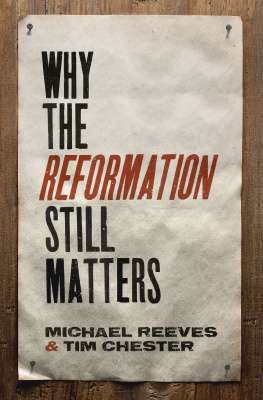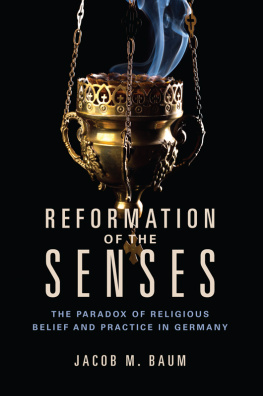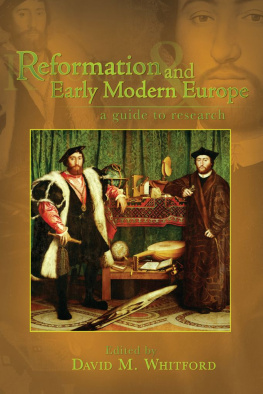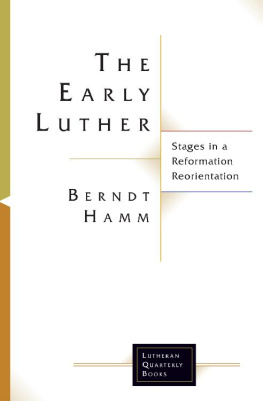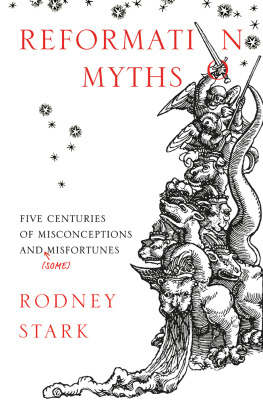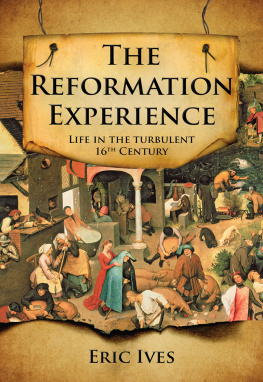The Spatial Reformation
INTELLECTUAL HISTORY
OF THE MODERN AGE
Series Editors
Angus Burgin
Peter E. Gordon
Joel Isaac
Karuna Mantena
Samuel Moyn
Jennifer Ratner-Rosenhagen
Camille Robcis
Sophia Rosenfeld
The
SPATIAL
REFORMATION
_________________
Euclid Between Man,
Cosmos, and God
Michael J. Sauter

Copyright 2019 University of Pennsylvania Press
All rights reserved. Except for brief quotations used for purposes of review or scholarly citation, none of this book may be reproduced in any form by any means without written permission from the publisher.
Published by
University of Pennsylvania Press
Philadelphia, Pennsylvania 19104-4112
www.upenn.edu/pennpress
Printed in the United States of America on acid-free paper
1 3 5 7 9 10 8 6 4 2
Library of Congress Cataloging-in-Publication Data
Names: Sauter, Michael J., author.
Title: The spatial reformation : Euclid between man, cosmos, and God / Michael J. Sauter.
Other titles: Intellectual history of the modern age.
Description: 1st edition. | Philadelphia : University of Pennsylvania Press, [2019] | Series: Intellectual history of the modern age | Includes bibliographical references and index.
Identifiers: LCCN 2018020825 | ISBN 9780812250664 (hardcover)
Subjects: LCSH: EuropeIntellectual lifeHistory. | SpacePhilosophyHistory. | EuclidInfluence. GeometrySocial aspectsHistory. | SpaceSocial aspectsHistory. | EuropeCivilizationHistory.
Classification: LCC CB203 .S28 2019 | DDC 940.1dc23
LC record available at https://lccn.loc.gov/2018020825
This one is expressly for Allyson
But you must note this: if God exists and if he really did create the world, then, as we all know, he created it according to the geometry of Euclid and the human mind with the conception of only three dimensions in space. Yet there have been and still are geometricians and philosophers, and even some of the most distinguished, who doubt whether the whole universe, or to speak more widely the whole of being, was only created in Euclids geometry; they even dare to dream that two parallel lines, which according to Euclid can never meet on earth, may meet somewhere in infinity. I have come to the conclusion that, since I cant understand even that, I cant expect to understand about God. I acknowledge humbly that I have no faculty for settling such questions, I have a Euclidean earthly mind, and how could I solve problems that are not of this world? And I advise you never to think about it either, my dear Alyosha, especially about God, whether he exists or not. All such questions are utterly inappropriate for a mind created with an idea of only three dimensions.
Fyodor Dostoyevsky, The Brothers Karamazov (1880), trans. Garnett
Contents
_________
_________
This book took too long to complete and was supposed to be a study of public clocks and time discipline in the late eighteenth century. These two things are related. Initially, I was interested in how, at the eighteenth centurys end, people across Europe yielded the right to define local time to astronomers, an exclusive group whose knowledge and skills were expressly not local, but were tethered to a far-flung community of specialists. My work on this matter appeared in 2007 as a journal article, in which I detailed eighteenth-century Berlins experience with modern time regimes. Everything went awry, from there.
In order to pursue the formation of what I understood to be modern time sense, I undertook to study the history of astronomy. (I believe, now, that I was wrong about time disciplines modernity. This discipline was, in fact, early modernfor reasons that will become clear.) Thus, when I first expanded my inquiry, I was interested in how astronomys maturation into a continental discipline sustained multiple takeovers of local time regimes. In short, I wanted to explore how time ceased to be a form of local knowledge, in the sense that Clifford Geertz has used the term, and became a scientific form of knowledge that was incorporated rapidly into the European states burgeoning disciplinary apparatus.
As I tumbled backward into the history of astronomy, however, I detected similarities in early modern astronomical textbooks with philosophical works that I had previously studied. I recalled, for instance, that the German philosophers Immanuel Kant and Johann Gottfried Herder had deployed in their writings the same astronomical knowledge that I was encountering within eighteenth-century astronomical works. Herder, for instance, dedicated the entire first book of his anthropological work Ideas on the History of Humanity (17881791) to a description of the cosmos, imagining for his readers terrestrial and extraterrestrial realms that he had never seen, before analyzing a humanity that he could not have fully known. Thus, the great unseen cosmosto which Herder had access through books, scientific instruments, and the university lectures that he heard in Prussian Knigsbergwas an essential (and essentially imagined) frame of reference for his anthropology. When I noticed that the initial volume of Herders work appeared one year after Berlin, Prussias capital city, had installed its first master clock, it appeared that astronomy was behind a much broader change.
Further research in the history of anthropological thought revealed that Herder was not alone in projecting an unseen cosmos as the essential backdrop for a proper study of humanity. The same phenomenon appeared in other fundamental eighteenth-century works of anthropology, including Natural History (17491804) by the Comte de Buffon, Essay on Man (1734) by Alexander Pope, and Reasonable Thoughts on the Workings of Nature (1725) by Christian Wolff., Strangers to the World, in which I explore the background to (and significance of) anthropologys embrace of heliocentrism.
This projects conceptual starting point thus forms the resulting monographs final chapter. I note this fact in order to elucidate how an investigation into the rise of public clocks metastasized into a history of spatial thought. This book was researched and written backward. The various astronomical texts that I read pulled me back nolens volens to earlier times and into other disciplinary fields. It turned out, for example, that eighteenth-century and seventeenth-century textbooks in astronomy linked the discipline to geography, often claiming cheekily that geographers would be lost were astronomers not around to tell them where they were. Nor did geographers dispute the point. Subsequent research into the terrestrial discipline, beginning with the eighteenth century and moving back into the seventeenth, then led me into yet more branches of learning, including sixteenth-century cosmography and fifteenth-century globe making. Thus, I began to see how astronomers, geographers, cosmographers, and globe makers produced collectively what Europeans could not see. Not coincidentally, I became lost in space.
While pursuing what struck me as interrelated traditions of imagining unseen realms, I noticed that texts from the varied disciplines paid homage to geometry. More significantly, perhaps, the works in question often recommended that readers study early modern geometrys cornerstone, Euclids Elements. That the exhortations were made so easily and so regularly suggested, in turn, that ancient geometry had already become fundamental to early modern thought, before the astronomical issues that I was pursuing rose to prominence. Thus, I began to , The Renaissance and the Round Ball. In each chapter I explore how Euclidean geometric spaces reception not only changed the discipline in question, but also wrought a broad consensus: that geometry undergirded all forms of natural knowledge.
Next page

